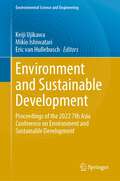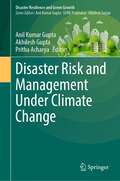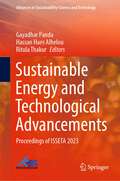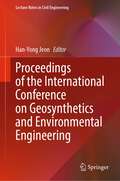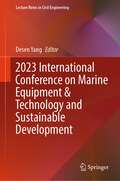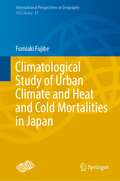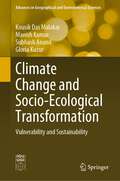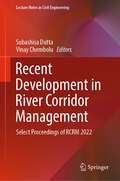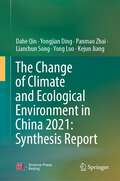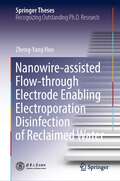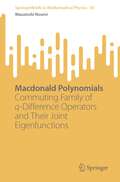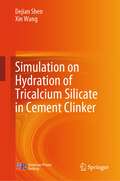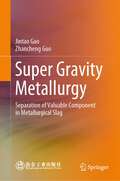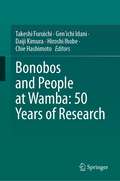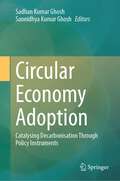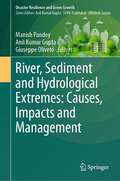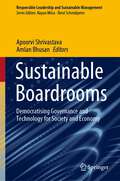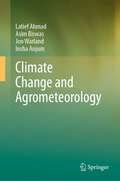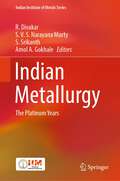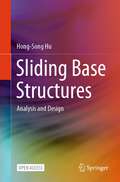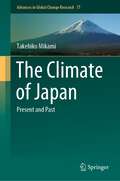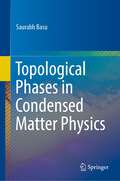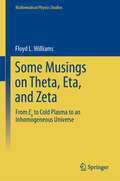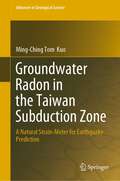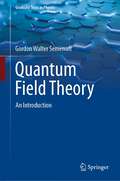- Table View
- List View
Environment and Sustainable Development: Proceedings of the 2022 7th Asia Conference on Environment and Sustainable Development (Environmental Science and Engineering)
by Keiji Ujikawa Mikio Ishiwatari Eric Van HullebuschThis book presents selected papers from the 2022 7th Asia Conference on Environment and Sustainable Development, which was held in Kyoto, Japan, November 4–6, 2022. The event was co-sponsored by the International Network for Environmental and Humanitarian Cooperation, and technically supported by Yokohama National University and the National Institute for Environmental Studies, Japan. The book focuses on environmental restoration and ecological engineering, global environmental change and ecosystems management, environmental dynamics, wastewater and sludge treatment, air pollution and control, and environmental sustainability. The volume is a valuable resource for those in both academia and industry.
Disaster Risk and Management Under Climate Change (Disaster Resilience and Green Growth)
by Anil Kumar Gupta Akhilesh Gupta Pritha AcharyaThis contributed volume is focused on SDG 3, 6, 7 ,9, 11, 15, and it covers extensive knowledge on damage and loss contexts of climate change in a developing country. India’s vast landscape with its diversity of eco-geo-physiography, socio-cultural, and developmental settings, coupled with climate change and anthropogenic factors, makes it one of the most disaster-prone countries of the world and, thus, representing almost all the disasters and extreme events associated with climate change, variability, and weather phenomenon. Besides common hazards,such as heavy rainfall, floods, drought, cyclone and heat wave, secondary and composite disasters like forest fires and disease epidemics are also covered with case studies and examples. Cross-cutting aspects like infrastructure resilience, gender and social equity concerns, legal and assessment tools, and futuristic vision have been covered well in the book. Disaster risk reduction, preparedness, and resilience as central themes of adaptation to climate change are presented through policy discussions, tools, and strategic analysis of past and recent lessons. This book is of common interest to a wider range of readers across policyplanning, academia, research, and professional practitioners having interest in adaptation, resilience building and sustainability in developing countries of the world. Though it is primarily a reference book, it can also serve as a textbook for university courses and professional trainings in climate change adaptation, disaster management, sustainability and strategic management studies.
Sustainable Energy and Technological Advancements: Proceedings of ISSETA 2023 (Advances in Sustainability Science and Technology)
by Gayadhar Panda Hassan Haes Alhelou Ritula ThakurThis book contains selected papers presented at Second International Symposium on Sustainable Energy and Technological Advancements (ISSETA 2023), organized by the Department of Electrical Engineering, NIT Meghalaya, Shillong, India, during February 24–25, 2023. The topics covered in the book are the cutting-edge research involved in sustainable energy technologies, smart building technology, integration and application of multiple energy sources; advanced power converter topologies and their modulation techniques; and information and communication technologies for smart micro-grids.
Proceedings of the International Conference on Geosynthetics and Environmental Engineering (Lecture Notes in Civil Engineering #374)
by Han-Yong JeonThis book presents selected papers from the Proceedings of the International Conference on Geosynthetics and Environmental Engineering, ICGEE 2023, held in Jeju Island, South Korea, covering topic areas in geosynthetic applications and sustainability; civil and structural engineering; and environmental engineering and science. The published articles cover the latest research studies with the focus of discussing the relationship between geotechnical materials and environmental engineering in depth to solve complex geosynthetics issues in civil and environmental engineering. It also highlights state-of-the-art technologies adopted by the relevant industries which are not only commercially viable but also environmentally sustainable. The content of the papers appeals to researchers and industrial practitioners working in the field of geoengineering.
2023 International Conference on Marine Equipment & Technology and Sustainable Development (Lecture Notes in Civil Engineering #375)
by Desen YangThis book contains original, peer-reviewed, and selected research papers that were presented at the 2023 International Conference on Marine Equipment & Technology and Sustainable Development, which took place in Beijing, China on April 1st 2023. The papers cover a range of topics, including but not limited to: the vision and goals of building a maritime community with a shared future, marine machinery and transportation, marine ecology, environmental protection and conservation, marine safety, future ships and marine equipment, marine engineering, marine information and technology, maritime policy, and global governance.The papers included in this volume provide the latest findings on methodologies, algorithms, and applications in marine equipment and technology, as well as sustainable development. As a result, this book is an invaluable resource for researchers, engineers, and university students who are interested in these fields.
Climatological Study of Urban Climate and Heat and Cold Mortalities in Japan (International Perspectives in Geography #21)
by Fumiaki FujibeThis book describes observed features of urban climate and its long-term variations as well as the relationship of climate to heat stroke in Japan, based on observational data and statistical analyses. Consisting of three parts, the book is a valuable resource for researchers and professionals involved with these topics. Part 1 focuses on urban climate. The basic characteristics of heat islands are reviewed, and long-term urban warming is described with a focus on the distinction from global warming. The influence of microscale environmental changes on the observed temperature is also presented, as well as changes in wind and precipitation in urban areas. They deepen our understanding of the features and mechanisms of urban heat islands and their long-term changes. Part 2 describes the climatological features of heat stroke mortality, which has become a major social problem in Japan, using mortality statistics and meteorological data. The spatial and temporal variations of heat stroke mortality are analyzed quantitatively on various spatial and temporal scales. In addition, the number of ambulance transports is examined as another measure of heat stroke casualty. The results provide insight into the climatological factors related to heat stroke mortality and contribute to the implementation of preventive measures. The climatology of deaths from extreme cold is also presented. For supplementary information, an overview of the geography, climate, and meteorological data of Japan is presented in Part 3.
Climate Change and Socio-Ecological Transformation: Vulnerability and Sustainability (Advances in Geographical and Environmental Sciences)
by Kousik Das Malakar Manish Kumar Subhash Anand Gloria KuzurThis book focuses on various psycho-social and socio-physical aspects of climate change and includes a wide range of case studies. Included topics are notable climate-related social thinking; climate vulnerability; transformation in socio-ecological subsystems; bioclimatological, urban bioclimatological and socio-bioclimatic ideas; disasters; policy instruments; climate justice; human rights; and sustainability. The book distinguishes itself from similar works by including a wide variety of topics and assists policy management in the current and upcoming climate crisis era. This book also addresses the Sustainable Development Goals 13 (Take Urgent Action to Combat Climate Change and Its Impacts), highlighting resilience, recovery potential and adaptive capacity, climate change measures integrated into policies and planning, and knowledge and capacity to mitigate climate change. The ideas covered in this book evolved in response to the current climate crisis, ideas that the authors believe will aid in societal management and development in the present and future. The book is a useful source for planners, geographers, professionals, academics, government officials, laypeople, and others interested in climate change.
Recent Development in River Corridor Management: Select Proceedings of RCRM 2022 (Lecture Notes in Civil Engineering #376)
by Subashisa Dutta Vinay ChemboluThis book presents the select proceedings of the 2nd International Conference on River Corridor Research and Management (2022). It describes various topics on fluvio-hydro-ecological processes of river systems. The topics covered include river hydraulics, river dynamics, experimental and field hydraulics and remote sensing applications. The book also discusses the river aquatic health, river ecology and other aligned areas. The book is a valuable reference for research scholars, academicians, river scientists and practitioners working in the areas of river science.
The Change of Climate and Ecological Environment in China 2021: Synthesis Report
by Dahe Qin Yongjian Ding Panmao Zhai Lianchun Song Yong Luo Kejun JiangThis book analyzes China's climate and environmental change facts, impacts and vulnerabilities, and mitigation strategies. On basis of synthesis assessment, through comprehensive integration, it focuses on four aspects: climate change and ecological environment evolution, future climate change and risk prediction, technical measures and action results for adaptation and mitigation, and development path with climate resilience. In terms of change facts, it focuses on extreme climate events, large-scale factors affecting China's climate change, and the impact of climate change on China's social and economic system. In terms of future risks, it focuses on key variables such as temperature, precipitation and other key variables and the prediction of future changes in extreme climate events. Potential risks in resources, agriculture, cryosphere, ecology, human settlements, health and major projects are also discussed. In terms of adaptation and mitigation, this book systematically sorts out and summarizes the effects, policy choices and synergies of climate change adaptation and mitigation from two perspectives, global and Chinese. Finally, from the perspectives of carbon emission path, sustainable development, and building a community with a shared future for mankind, it explains the essentials of choosing a development path with climate resilience.
Nanowire-assisted Flow-through Electrode Enabling Electroporation Disinfection of Reclaimed Water (Springer Theses)
by Zheng-Yang HuoThis Ph.D. book develops nanowire-assisted electroporation disinfection technology based on the flow-through porous electrode. The author presents pioneering results on theoretical modeling, experimental realization, and selected applications, showing the novel disinfection mechanism of electroporation guarantees an exceedingly low level of energy consumption. In this regard, three classes of novel dynamic behavior are investigated: (i) The developed nanowire-assisted flow-through electroporation disinfection technology enables great microbial disinfection performance with extremely low voltage (1V), which significantly reduce the formation potential of harmful disinfection by-products during the treatment process. (ii) The nanowire-assisted flow-through electroporation disinfection technology ensures no reactivation/regrowth of inactivated bacteria and meanwhile promotes the gradual death of damaged bacteria during the storage process. (iii) The application of high-frequency AC power supply (106 Hz) ensures the high microbial disinfection efficiency while suppressing the occurrence of electrochemical reactions and extending the electrode lifetime effectively.
Macdonald Polynomials: Commuting Family of q-Difference Operators and Their Joint Eigenfunctions (SpringerBriefs in Mathematical Physics #50)
by Masatoshi NoumiThis book is a volume of the Springer Briefs in Mathematical Physics and serves as an introductory textbook on the theory of Macdonald polynomials. It is based on a series of online lectures given by the author at the Royal Institute of Technology (KTH), Stockholm, in February and March 2021. Macdonald polynomials are a class of symmetric orthogonal polynomials in many variables. They include important classes of special functions such as Schur functions and Hall–Littlewood polynomials and play important roles in various fields of mathematics and mathematical physics. After an overview of Schur functions, the author introduces Macdonald polynomials (of type A, in the GLn version) as eigenfunctions of a q-difference operator, called the Macdonald–Ruijsenaars operator, in the ring of symmetric polynomials. Starting from this definition, various remarkable properties of Macdonald polynomials are explained, such as orthogonality, evaluation formulas, and self-duality, with emphasis on the roles of commuting q-difference operators. The author also explains how Macdonald polynomials are formulated in the framework of affine Hecke algebras and q-Dunkl operators.
Simulation on Hydration of Tricalcium Silicate in Cement Clinker
by Dejian Shen Xin WangThis book is written based on authors' research on cement hydration during the past decade. It establishes simulation model to evaluate the influence of crystal defects on the dissolution of tricalcium silicate and morphology change of particles and explores the hydration kinetics and microstructure development of tricalcium silicate under the mixed control of dissolution, diffusion, as well as boundary nucleation and growth. It also provides a theoretical basis for regulating the microstructure and performance of cement-based materials. It is designed as a reference work for professionals or practitioners and as a textbook for undergraduates or postgraduates. This book provides valuable knowledge and useful methods that can be applied in the field of cement hydration.
Super Gravity Metallurgy: Separation of Valuable Component in Metallurgical Slag
by Jintao Gao Zhancheng GuoThis book introduces super gravity metallurgy in separation of valuable component in metallurgical slag. It collects the principle, apparatus and research for super gravity high-temperature metallurgy and the novel technology for selective crystallization and separation of various valuable components in different metallurgical slags by super gravity. Furthermore, the research results previously scattered in many journals and conferences worldwide are methodically edited and presented in a unified form. The book is likely to be of interest to university teachers, researchers, R&D engineers and graduate students in pyrometallurgy and extractive metallurgy who wish to explore innovative methods and technologies that lead to more efficient and environmentally sustainable utilization of metallurgical slag.
Bonobos and People at Wamba: 50 Years of Research
by Takeshi Furuichi Gen'Ichi Idani Daiji Kimura Hiroshi Ihobe Chie HashimotoThis book reviews all the findings about bonobos and the local people of Wamba village in the Luo Scientific Reserve in the Democratic Republic of the Congo over the last 50 years. In 1973, Takayoshi Kano, a Japanese primatologist, traveled across a vast area of the Congo Basin with a bicycle and found Wamba village to be a promising site to start his first studies on wild bonobos. Since then, many researchers from Japan and all over the world have been working at Wamba, now the longest standing study site, to uncover various aspects of the ecology and behavior of this most recently identified great ape species. The researchers study bonobo behaviors and carry out various activities for the conservation of bonobos. They also conduct anthropological studies of local people who live with bonobos and believe them to be distant relatives from the same family, living in the forest. This book is published in commemoration of 2023 marking the 50th year of study. The main chapters are contributed by active researchers studying bonobos and the local people at Wamba. The book also includes contributions from various eminent researchers who have carried out short-term research or have supported research at Wamba, which helps place these studies of bonobos in a broader primatological or anthropological perspective. This book will be a useful resource for professional researchers in primatology and anthropology, as well as graduate or undergraduate students interested in these research fields.
Circular Economy Adoption: Catalysing Decarbonisation Through Policy Instruments
by Sadhan Kumar Ghosh Sannidhya Kumar GhoshThis edited book brings out a comprehensive collection of information on principle and policy of circular economy. It deals with the general principles, pathways of circular economic development in different countries, use of circular economy in achieving sustainable development goals. The book covers policy instruments that helps implementing resource efficient processes, strategies of implementing circular economy concepts, Decarbonisation, and developing business promoting circular economy principles. The circular economy has gained increasing prominence as a tool which presents solutions to some of the world’s most pressing sustainable development challenges. By addressing root causes, the concept of a circular economy, an economy in which waste and pollution do not exist by design, products and materials are kept in use, and natural systems are regenerated provides promise to achieving SDGs. This book is of interest and use to practitioners, capacity builders and policymakers, entrepreneurs, NGOs, general people, and valuable source of reference to the relevant researchers and students in global markets. As circular economy is gaining momentum and interest in general, the book serves as reading material for undergraduate and graduate students in any field specifically environmental science, waste management, medical science as well as environmental management at national and international level.
River, Sediment and Hydrological Extremes: Causes, Impacts and Management (Disaster Resilience and Green Growth)
by Manish Pandey Anil Kumar Gupta Giuseppe OlivetoThis edited book provides a platform for knowledge sharing in all areas related to the rivers, sediment and hydrological extremes. It explains the hypothesis that river flow and sediment transport are intimately linked to erosion, scour and sediment deposition. Sediment transport, erosion and deposition are driven by local base-level changes and are highly variable in space and time. These concepts have serious implication for understanding the recent development of the River, Sediment and Hydrological Extremes.The natural hazards posed by hydrologic events and river systems depend on the uncertainty of hydrological events. This ability is affected by change in climatic conditions. Climate change studies have revealed that the frequency of extreme weather phenomena with increasing damage to human assets has gradually grown worldwide. As a consequence, rainfall events concentrated in time and space are expected to lead to serious local flooding and sediment transport in many parts of the world. Floods are remarkable hydro-meteorological phenomena and forceful agents of geomorphic evolution in most physical geographical belts and, from the viewpoint of human society, among the most important environmental hazards. According to the Indian Environment Agency, floods rank as number one on the list of natural disasters in India over the past decade.This book is an attempt to fill the gap in literature and bring forth evidence based latest research about precise estimation of erosion and scour, which is essential to reduce the hazards. The book explains that lack of preparedness and appropriate adaptation strategy makes people more risk-prone. It highlights the vulnerability in South Asia region about the impacts of flood, sediments, and river hazards because a large portion of its population depends on sensitive sectors like agriculture and forestry for livelihoods and several other reasons.The book is relevant for academician, researchers and students of disaster management, hydrology and ecology.
Sustainable Boardrooms: Democratising Governance and Technology for Society and Economy (Responsible Leadership and Sustainable Management)
by Apoorvi Shrivastava Amlan BhusanThis book discusses various interactions in the sustainability and development sector. It presents a thematic approach to describe progressive models and cases on disruptions, innovations, regulatory and institutional evolution related to the area of sustainability, through an organizational and boardroom level governance lens. It documents how certain schools of thought, models of engagement and methods-platforms-practices impact society and while doing so, brings together varying theoretical debates, practicing models and instruments of transformation in green governance. Sustainable policy making demands a whole of government approach in decision-making processes. Further, inclusiveness and ‘green’ consciousness of corporate boardrooms are paramount, without which, effective socially responsible business practices are absurd. Human resource development, shaped on sustainable corporate ethics, requires well-trained sustainability specialists, managers that can think ‘green’ in their overall decision making which are essential for green governance. In this context, the book creates a functional, interpretive repertoire of stories, commentaries, life experiences, and reflections of corporate leaders, academics, and practicing consultants, on their decision-making processes, and how they interpret sustainability. These stories and thoughts help create a functional academic construct, which will assist academics teach ‘green’ competencies to business school students better, and entrepreneurs and business executives to better understand the idea of sustainable growth.
Climate Change and Agrometeorology
by Latief Ahmad Asim Biswas Jon Warland Insha AnjumThe monograph focuses on agricultural meteorology and climate change and its impacts on different crops. Comprising of chapters from experts, the book discusses and provides first-hand information to the long term shifts in weather patterns and temperature impacting soil, water and crops. Each chapter focuses in detail on the impact of plant- water – soil nexus and climate change on agriculture and food security. Covering the basic concepts about the temperature, pressure and humidity correlation with the increased demands of food, the book explores in detail the impact of adverse climatic conditions like drought, floods, increasing levels of carbon dioxide emissions and other simultaneous effects like soil fertility depletion on the cropping systems and overall crop productivity. The book touches the challenges of climate change, adaptive methods, mitigation strategies, with careful explanation of governance, plans and policies required to provide guidelines to stake holders so they can best prepare for the negative climate change impacts. While touching the agricultural challenges faced globally due to climate change, the book serves as a reference book for students, researchers and policy makers, involved in horticulture, agriculture and environmental sciences and climate change.
Indian Metallurgy: The Platinum Years (Indian Institute of Metals Series)
by R. Divakar S. V. S. Narayana Murty S. Srikanth Amol A. GokhaleThe book marks the Platinum Jubilee of the Indian Institute of Metals, closely matching independent India's age. It is envisaged as a compilation of technical articles tracing the birth and growth trajectory of metallurgical science, engineering and technology in the nation, attempting a degree of prognostication covering the next quarter of a century. It contains the essence of the metallurgical research and development and industrial progress India has witnessed in the last 75 years. This book comprises technical articles written by industry leaders and eminent technocrats. It includes overviews by distinguished researchers who have strived to build foundations of new metallurgical research and engineering fields. It includes learned writings of persons associated with premier institutions heavily dependent on metallurgy and materials. They have made seminal contributions by nurturing the growth of metallurgical research and industrial production or have made first-hand contributions to building the great organisations we have today. Coinciding with the Platinum Jubilee year of the Indian Institute of Metals, this book brings out the enormous efforts of these individuals representing their organisations to share insights that led to their success as an entity. Similarly, several professionals who significantly contributed to the understanding of metallurgical engineering, have held important positions and steered the national strategic programmes or academically nurtured students in their illustrious careers also share their journey in this book. This book chronicles the significant advances made in the field of metallurgical science, engineering and technology in India, presenting the historical perspective and prospects in the format of a technical volume.
Sliding Base Structures: Analysis and Design
by Hong-Song HuThis open access book is an efficient and economic approach for mitigating the seismic damage of low-rise buildings. This book presents various aspects of SB structures, including their fundamentals, dynamic analysis procedures, seismic response characteristics, design methods, and practical applications. It contains a comprehensive study on the influence of various structural and ground motion characteristics on the responses of SB structures, which is particularly helpful for the readers to fully understand the behavior of SB structures. Researchers and engineers in the field of structural engineering and earthquake engineering will benefit from this book.
The Climate of Japan: Present and Past (Advances in Global Change Research #77)
by Takehiko MikamiThis book clarifies the climatic variations in Japan from the historical period to the present based on documentary sources and meteorological data. Japanese society has suffered from various kinds of natural disasters since ancient times, such as floods and high tides caused by torrential rainfall and strong winds. They were described in large numbers of historical documents including official local weather diaries. However, all these documents were written in Japanese or Chinese languages, which prevents non-readers of those languages from accessing them. Also, Japan is a Far Eastern island country, and the unique features of Japanese climate and natural disasters would be unfamiliar and unimaginable to them without being able to read those documents. How is the climate of Japan, and how was the climate during the Little Ice Age in Japan as compared with conditions in Europe and America? When did meteorological observations start, and who (which country) introduced them to Japan? Why did so many natural disasters occur in Japan, and what caused them? This book answers these questions as specifically and objectively as possible using both figures and photographs, which are beneficial to students and the general public who are interested in historical and current climatic change in Japan, as well as professional climate scientists.
Topological Phases in Condensed Matter Physics
by Saurabh BasuThe book is mainly designed for post-graduate students to learn modern-day condensed matter physics. While emphasizing an experiment called the ‘Quantum Hall effect’, it introduces the subject of 'Topology' and how the topological invariants are related to the quantization of the Hall plateaus. Thus, the content tries to deliver an account of the topological aspects of materials that have shaped the study of condensed matter physics in recent times. The subject is often quite involved for a student to grasp the fundamentals and relate them to physical phenomena. Further, these topics are mostly left out of the undergraduate curriculum, although they often require a simplistic view of the concepts involved to be presented pedagogically. The book contains examples, worked-out concepts, important derivations, diagrams for illustration, etc. to aid the understanding of the students. The book also emphasizes the experimental discoveries that put the subject in its perspective and elaborate on the applications which are likely to be of interest to scientists and engineers.
Some Musings on Theta, Eta, and Zeta: From E8 to Cold Plasma to an lnhomogeneous Universe (Mathematical Physics Studies)
by Floyd L. WilliamsThis book continues the applications of mathematics, more specifically of theta, eta, and zeta functions, and modular forms, to various areas of theoretical physics. It is a follow-up and extension in some sense of the author’s earlier book entitled A window into zeta and modular physics. Some of the main topics are1. A new approach to logarithmic corrections to black hole entropy2. My recent work that provides for an explicit cold plasma-black hole connection3. Generalization of work of physicists on certain asymptotic problems relating to string theory, for example, by way of the general theory of modular forms of non-positive weight4. A construction of the E8 root lattice, its theta function, and its relevance for heterotic string theory5. Applications of elliptic functions to KdV, nonlinear Schrödinger, and Duffing equations, for example, including a discussion of Lax pairs and the Miura transformation6. Finite temperature zeta functions and partition functions for quantum fields in thermal equilibrium on various curved background spacetimes7. Exact solutions of the Einstein gravitational field equations for Lemaitre and inhomogeneous cosmological models, with a special focus on the Szekeres–Szafron exact solutions by way of the Weierstrass elliptic function8. Elementary particles and my zeta function formula for higher spin fermionic particles; this covers, in particular, the gravitino particle (of spin 3/2) and bosons with integral spin s = 2, 3, 4, 5.These are some sample topics. Others include the continuous Heisenberg model, reaction diffusion systems, Dirichlet and Hecke L-functions, the modular j-invariant, the computation of the one-loop effective potential for non-compact symmetric spaces, the BTZ black hole, Jacobi inversion formulas, etc.Thus, there is a very large range of material with the first 9 chapters of preliminary, expositional background for mathematicians and physicists.
Groundwater Radon in the Taiwan Subduction Zone: A Natural Strain-Meter for Earthquake Prediction (Advances in Geological Science)
by Ming-Ching Tom KuoThis book presents the mechanism of in-situ radon volatilization and outlines the geological requisites to site a radon monitoring well for earthquake warning. A small fractured aquifer under undrained conditions is an effective natural strain meter for earthquake prediction. It shows significant merit on a local basis, and most importantly, the analysis can also be applied globally in subduction zones with similar tectonic settings and physical–chemical relationships.Between 2003 and 2010, anomalous declines in groundwater radon concentration were recurrently recorded at Antung, Taiwan, which are considered as precursory to local major earthquakes. The correlations between radon decline and earthquake magnitude are useful for early warning of local main earthquakes. The book consists of 7 chapters. Chapter 1 presents background information and the objectives of the book. Chapter 2 illustrates the methods of monitoring groundwater radon and a brief review of earthquake prediction research using groundwater radon. Chapter 3 provides the details of anomalous decrease in groundwater radon before the Taiwan Mw 6.8 Chengkung Earthquake of 2003. Chapter 4 provides the description of the mechanism of groundwater-radon volatilization. Chapter 5 shows the recurrent anomalous declines in groundwater radon concentration consistently recorded at Antung, Taiwan, prior to local main earthquakes that occurred between 2003 and 2010. Monitoring groundwater radon in small, unconfined fractured aquifers is explained in Chapter 6, followed by an analysis of correlating precursory declines in groundwater radon, precursory time with earthquake magnitudes for small, confined fractured aquifers in Chapter 7.
Quantum Field Theory: An Introduction (Graduate Texts in Physics)
by Gordon Walter SemenoffThis textbook is intended to be used in an introductory course in quantum field theory. It assumes the standard undergraduate education of a physics major and it is designed to appeal to a wide array of physics graduate students, from those studying theoretical and experimental high energy physics to those interested in condensed matter, optical, atomic, nuclear and astrophysicists. It includes a thorough development of the field theoretic approach to nonrelativistic many-body physics as a step in developing a broad-based working knowledge of some of the basic aspects of quantum field theory. It presents a logical, step by step systematic development of relativistic field theory and of functional techniques and their applications to perturbation theory with Feynman diagrams, renormalization, and basic computations in quantum electrodynamics.
